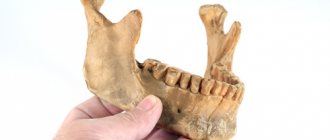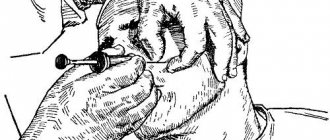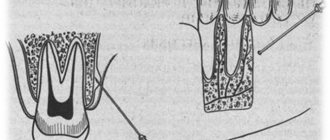Home » All about modern dentistry » Pain relief in dentistry » Pain relief in the upper jaw For various operations on the upper jaw, dentists prefer to use infiltration anesthesia. This method is most convenient because the thin layer of the compact lamina of the alveolar process of the upper jaw is porous. If you use modern painkillers that have a high diffusion ability, then with this method of their administration the desired anesthetic effect is achieved.
Impregnation of tissues and alveolar processes with an anesthetic is carried out by injection, injecting the solution under the mucous membrane at an angle of 40-45o in the projection of the upper areas of the dental roots along the transitional fold of the vestibule of the oral cavity in the area that is supposed to be operated on. If this area is too large, the needle is moved along the transitional fold and the anesthetic solution is slowly injected. Because rapid administration of the substance can cause pain in the patient.
To anesthetize the palatal tissues, an injection of an anesthetic drug is made into the angle formed by the palatine and alveolar jaw processes, at a distance of 10-15 mm from the edge of the gum.
Regional (conduction) anesthesia is used quite rarely; it includes anesthesia on the tubercle of the upper jaw, in the area of the greater palatine, incisive and infraorbital foramen.
Intraoral anesthesia
The patient's mouth is in a half-open state, the doctor inserts a mirror into the oral cavity, moving the cheek to the side. This ensures an excellent overview of the arch of the vestibule of the mouth, as well as tension in the mucous transitional fold near the molars. The needle is inserted into the mucosa above the projection of the apexes of the teeth at the level of the 2nd and 3rd molars. If there are no molars, then the needle should be behind the zygomaticalveolar ridge and move up, back and inward. The insertion angle should be 45°. It is necessary to control that the needle always moves along the bone with the beveled surface of its tip. During this movement, the anesthetic should be gradually injected. This method will help prevent injuries to the vessels of the pterygoid plexus. Having deepened the needle by 2-2.5 cm, the anesthetic solution is deposited. Thus, the molars located on the side of the vestibule of the mouth, the mucous membrane, periosteum and the outer posterior bone wall of the maxillary sinus are perfectly anesthetized.
Extraoral anesthesia
Having made a puncture with a needle in the area of the lower anterior corner of the cheek bone, the needle is then directed upward at an angle of 45° and again towards the tubercle of the upper jaw, bringing it to the bone. And then the anesthetic solution is deposited. The anesthetic effect occurs in approximately the same time as with the intraoral method of anesthesia.
However, during the process of anesthesia, a hematoma appears on the tubercle of the upper jaw, which is a consequence of injury to the veins of the pterygopalatine plexus by the needle.
Computed tomography studies of the path of solution propagation during tuberal anesthesia confirmed that such complications are most likely.
This tomogram, which was taken 5 days after intraoral anesthesia, shows that there are contours of a hematoma on the tubercle of the upper jaw in the pterygopalatine fossa. Approximately 40-60% is allocated to the fact that this cellular formation will fester and turn into phlegmon.
When using the tuberal method of anesthesia, injury to the veins of the pterygopalatine plexus is almost impossible to avoid, and there is also a fairly high risk of complications, in particular if the intraoral method is used. All this threatens the health and even the life of the patient. That is why it is recommended to use this type of anesthesia extremely rarely.
Orbital route of infraorbital anesthesia
We have already emphasized that for successful infraorbital conduction anesthesia to obtain complete anesthesia not only of the outer mucous membrane and periosteum in the area of the five upper teeth, from the central incisor to the second premolar, but also of these teeth themselves, the bone walls of the upper jaw and the maxillary mucosa cavity in the corresponding area, this anesthesia should be performed intracanal, with the end of the needle entering the infraorbital canal by 8-10 mm. For extracanal infraorbital anesthesia, with the tip of the needle and anesthetic solution brought only to the infraorbital foramen, as a rule, well anesthetizes only the terminal branches of the infraorbital nerve emerging from the infraorbital foramen (the so-called lesser pes anserine), which innervate only the outer one in the zone of this anesthesia on the upper jaw mucous membrane and periosteum. The anterior and middle superior alveolar nerves, which extend from the infraorbital nerve in the infraorbital canal itself and the groove of the same name and innervate the indicated five teeth, the area of the upper jaw and the mucous membrane of the maxillary sinus within the specified limits, usually remain painless during extracanal anesthesia.
As our experience shows, only intracanal infraorbital conduction anesthesia well anesthetizes the tissues surrounding the tooth, the pulp and hard tissues of the tooth, which makes it possible not only to painlessly remove the tooth, but also to completely painlessly dissect the hard tissues of the tooth, as well as amputate and extirpate the pulp.
At the same time, it is not always easy when carrying out infraorbital conduction anesthesia (extraoral and especially intraoral) to get into the infraorbital foramen, from there go deeper into the canal of the same name and wash the infraorbital nerve with a solution in the canal itself, especially in the groove, in those places where it departs from the nerve its anterior and middle superior alveolar branches. This circumstance is associated not only with the different diameters of the infraorbital foramen and the canal of the same name in different people, but primarily with the fact that in different people the location of the infraorbital foramen and the direction of its mouth vary significantly.
Naturally, it is easy to perform conduction anesthesia with complete success in the case when the nerve to be anesthetized is accessible for washing away with an anesthetic liquid either before it enters the corresponding opening and canal, such as the posterior superior alveolar nerves and the inferior alveolar nerve, or after its exit from the foramen, as the anterior palatine nerve, as well as the maxillary and mandibular nerves.
We were faced with the question of whether it is possible to carry out infraorbital conduction anesthesia extracanal and still obtain complete anesthesia of both the terminal branches of the infraorbital nerve and those extending from it in the infraorbital canal and the groove of the same name of the anterior and middle superior alveolar nerves, innervating the area of the upper jaw ranging from the central incisor to the second premolar along with these teeth. In other words, we were faced with a question: is there a way of infraorbital conduction anesthesia in which the needle and anesthetic solution would be brought to an accessible part of the infraorbital nerve before the departure of the branches of interest to us, bypassing the hole and canal?
At the beginning of 1954, we proposed this path. It lies on the side of the eye socket.
It is known that on the lower wall of the orbit, close to the infraorbital margin, approximately 1 cm from it, the infraorbital groove runs sagittally, in which the infraorbital nerve lies freely, without bone covering, before its entry into the infraorbital canal, located at the level of the middle of the infraorbital margin and opening on the facial surface of the upper jaw with an infraorbital foramen.
Anesthesia of the infraorbital nerve
The purpose of this anesthesia is to block the branches of the inferior orbital nerve, which forms the lesser “crow's foot” in the area of its exit from the bony canal, as well as the middle and superior anterior alveolar branches.
The result of such anesthesia, performed at the lower orbital foramen, is pain relief:
- — Reztsov,
- - Fang,
- — Premolars,
- — The gums adjacent to the premolars in the area of the vestibule of the mouth,
- — Bone tissue of the alveolar process and nasal septum,
- — Shells of the mucous and bone structures of the walls of the maxillary sinus,
- - Skin of the infraorbital region of the lower eyelid and wing of the nose,
- — Mucous membrane and skin of the upper lip.
The projection of the infraorbital foramen, which is oriented towards during an anesthetic injection, is located 5 mm below the edge of the orbit, which corresponds to the axis drawn through the center of the eye pupil when the eye looks forward.
Complications of infraorbital anesthesia
1. Injury to the vessels located in the area of needle advancement. With this anesthetic injection, you can injure, firstly, the angular artery, the external maxillary artery and the anterior facial vein, art. angularis, art. maxillaris externa et vena facialis anterior (these vessels are crossed by the course of the needle). But we know that the vessels move to the side when the needle approaches them (this creates difficulties with intravenous injections), especially when the anesthetic solution is continuously released. Secondly, the infraorbital artery and accompanying veins can be injured here. Injury to these vessels occurs, according to some authors, in 2-3% of cases. In our practice, vascular injury with this anesthetic injection is a rarer occurrence.
The prevention of vascular injury and other complications that may arise from it will be discussed below.
2. The needle gets into the eye socket. To avoid this complication, you should not advance the needle into the depths of the infraorbital canal to a distance of more than 8-10 mm. If it happens that the end of the needle enters through the infraorbital canal into the orbit, for example, when the needle is advanced deeper into the canal or if its length is insignificant, then transient double vision and some swelling of the soft tissues surrounding the eyes can only occur; there are no more serious consequences. Only with extremely rough and deep advancement of the needle through the infraorbital canal into the orbit can the eyeball be injured.
3. Paresis of the muscular nerves of the eye (most often mi inferiores nervi oculomotorii). This complication occurs when an anesthetic solution gets into the eye socket. It is accompanied by transient double vision. But, as we said, the needle entering the orbit through the upper wall of the infraorbital canal when entering the canal no more than 10 mm is almost completely excluded.
4. If the solution enters the orbit through the lower orbital margin, it is revealed by swelling of the lower eyelid. There are no serious consequences from this.
5. Pallor of the facial skin at the beginning of the injection can also occur with this anesthesia, but here this phenomenon is not surprising, since the injection is performed near the vessels that directly supply the facial skin.
Area of spread of anesthesia. Typically, after infraorbital conduction anesthesia, the area from the middle of the upper central incisor to the middle of the upper second premolar on the labio-buccal side, including the corresponding area of the upper jaw and teeth, is anesthetized. Medial and lateral to this area, anesthesia does not occur due to anastomoses from the anterior superior alveolar nerves of the opposite side (medially) and from the posterior superior alveolar nerves of the same side (laterally).
Sometimes (although very rarely) the teeth are anesthetized only up to the canine (both incisors and the canine). This can be explained by the fact that the solution did not reach the nerve behind the infraorbital canal, where the middle superior alveolar nerves, which play a major role in nerve supply to the upper premolars, are almost always separated, which usually happens with extracanal infraorbital conduction anesthesia, or by the fact that the middle superior alveolar nerves arise outside the infraorbital canal and the groove of the same name (before the infraorbital nerve enters the orbit through the inferior orbital fissure), or, finally, by the fact that the upper premolars in this case are innervated by branches from the posterior superior alveolar nerves. In the mucous membrane on the palatal side, anesthesia does not occur, since this is the area innervated by the nasopalatine and anterior palatine nerves.
It must be added that, in addition to anesthesia of the upper jaw within the mentioned boundaries, with infraorbital conduction anesthesia we also achieve anesthesia of the lower eyelid (except for the lateral part), the side of the nose (except for the back and tip), half of the upper lip and the front part of the cheek. This is explained by the fact that after injection into the infraorbital canal, not only the area of branching of the anterior and middle superior alveolar nerves is anesthetized, but also the area of branching of the infraorbital nerve, protruding through the infraorbital foramen onto the anterior surface of the upper jaw (lesser pes anserine).
The intraoral technique of infraorbital conduction anesthesia is less successful than the extraoral one. This is due not only to the possibility of introducing an oral infection during the intraoral technique of this anesthesia, which is especially dangerous in a heavily infected oral cavity, but also to the fact that the technique of intraoral infraorbital conduction anesthesia is much more complicated than extraoral one. With an intraoral infraorbital anesthetic injection, it is necessary to deviate from the most important rule of conduction anesthesia on the jaws, which requires that the needle advanced into the depths of the perimaxillary soft tissues be kept close to the bone at all times. It should be emphasized that the need to insert a needle into the very infraorbital canal makes the intraoral technique of this anesthesia even more complex and reduces the likelihood of success.
The extraoral technique of infraorbital conduction anesthesia is easier and, therefore, more accessible.
Infraorbital conduction anesthesia, as indicated at the beginning, plays an important role in anesthesia of the upper jaw. When carried out intracanal, it completely anesthetizes almost two-thirds of the upper jaw. It can and should take pride of place among the methods of conduction anesthesia of the dental system. It can and should play almost the same role for anesthesia of the upper jaw as mandibular conduction anesthesia plays for conduction anesthesia of the lower jaw.
In case of failure, when we were unable to get into the infraorbital foramen and, consequently, into the infraorbital canal (this happened during the first time we developed this anesthesia), we released the anesthetic solution outside the infraorbital canal. This was sometimes relatively sufficient to anesthetize minor interventions (routine tooth extraction, etc.), and in cases where a significant and very painful intervention was to be performed, we used central conduction anesthesia at the round hole (about anesthesia at the round hole and the ways of its implementation, see . Further). Failures, i.e. cases of failure to enter the infraorbital canal, even with the extraoral technique of infraorbital conduction anesthesia are relatively common.
Wanting to reduce the percentage of such failures and bring it to a minimum even among inexperienced doctors, we set ourselves the task of modifying the technique of extraoral infraorbital conduction anesthesia. Having studied a large number of skulls and corpses for this purpose, we were convinced that the infraorbital foramen does not always open exactly obliquely downward and inward. In a significant percentage of cases, this hole is directed either only inward, or, more often, almost completely downward.
Considering the existence of these options for the direction of the infraorbital foramen, we recommend the following technique for performing extraoral infraorbital conduction anesthesia.
From the usual injection site, the needle is first directed obliquely, from below and from the inside, up and out. If it does not hit the infraorbital foramen, this way they switch to the direction from bottom to top, for which they slightly extend the needle and again, after moving the soft tissue at the injection site, slightly move it outward in the indicated direction (from bottom to top). In case of failure, take the direction from the inside to the outside, for which they again slightly extend the needle, lift the tissue at the injection site slightly upward, then direct the needle from the inside to the outside and enter the infraorbital foramen.
Our research, based on the study of over a hundred skulls for this purpose, has established the following regarding the options for the direction of the infraorbital foramen. In approximately 60% of cases, the orifice is directed obliquely downward and inward, in 25% - mainly downward and only slightly inward, and in 15% - mainly inward.
In the technique of extraoral infraorbital anesthesia, the depth of the canine fossa should also be taken into account. With a very deep canine fossa, getting the end of the needle stuck in it can prevent successful entry into the mouth of the infraorbital foramen. To avoid this, the injection begins closer to the projection site of the infraorbital foramen and, thus, has the opportunity to reach the area of the bone located above the canine fossa. With such an injection site, you can almost always easily get into the infraorbital foramen, even with a very deep canine fossa.
Intraoral access
Using the thumb and forefinger of the left hand, push the upper lip up and out, and with the middle finger hold the projection of the infraorbital foramen. With this type of access, it is located at the intersection of two axes. One of them, horizontal, runs 5-7 mm below the lower orbital margin, and the second, vertical, runs on the corresponding side along the axis of the second upper premolar. The needle must be inserted, retreating 5 mm from the upper edge of the attachment of the transitional fold between the lateral and middle incisors. Then it is pushed upward, forward and outward in the direction of the lower orbital foramen until it stops at the bone. And only there the anesthetic solution is released.
Anesthesia at the greater palatine foramen
This method blocks the innervation of the greater palatine nerve, thus achieving an anesthetic effect on the mucous membrane on the desired side of the hard palate, as well as on the alveolar process from the palate from the third molar to the middle of the short part of the canine. The anesthetized area can reach the lateral incisor, as well as the vestibular surface in the area of the third molar. In some patients the area extends to the second premolar.
The greater palatine foramen is located in the horizontal plate of the palatine bone and its pyramidal process at the base of the alveolar process, 5 mm anterior to the border of the soft and hard palate. Above the hole in the mucous membrane there is a small depression. The projection of the hole onto the mucous membrane of the hard palate is located at the intersection of two mutually perpendicular lines. The one that runs vertically goes through the middle of the line that connects the crest of the alveolar process and the center of the upper jaw, and the horizontal one runs through the middle of the coronal part of the third molar.
Anesthesia technique. The mouth should be opened wide, the syringe needle is directed from the opposite corner of the mouth and inserted 1 cm forward and inward in the direction from the projection of the opening of the palate into the mucous membrane. The needle is advanced until it comes into contact with the bone, and 0.5 ml of solution is injected. After a couple of minutes, the analgesic effect occurs. In the case when the solution is injected directly near the greater foramen of the palate, as well as into the opening of the pterygopalatine canal, the effect captures the posterior nerves of the palate emerging from its lesser foramen. As a result, the soft palate is numbed. Injecting the solution into this area may cause nausea and vomiting. Another side effect that may occur due to excessive injection of a solution under pressure is necrosis of the soft tissues of the hard palate. This can occur in patients with vascular atherosclerosis.
Technique for infraorbital anesthesia (injection site and needle direction)
The infraorbital foramen opens forward, downward and inward. The direction of the infraorbital canal is such that the extensions of the axes of both infraorbital canals intersect below the anterior nasal spine.
We insist that, in view of the origin of the anterior and middle superior alveolar nerves from the infraorbital nerve in the infraorbital canal itself and the groove of the same name, to obtain complete anesthesia from this conductive injection, it is not enough to bring the end of the needle only to the mouth of the infraorbital foramen and release the solution there, but you need to use a needle enter the most infraorbital canal 8-10 mm.
Other authors have found that by injecting an anesthetic fluid only near the infraorbital foramen, effective anesthesia can also be obtained. They suggest that to push the fluid into the canal, massage the soft tissue from the outside in the area of the infraorbital foramen.
We began to get very good results from infraorbital conduction anesthesia only when we began to insert a needle into the very infraorbital canal, and, since 1925, we have always performed infraorbital conduction anesthesia only intracanal. For only with this method of anesthesia can we achieve pain relief not only during normal tooth extraction, which can often be obtained, as mentioned above, with the help of correctly performed gingival infiltration anesthesia (the so-called plexual), but also during complex tooth extraction (such as gouging) and other surgical interventions on the anterior part of the upper jaw. The intracanal technique of infraorbital conduction anesthesia has an advantage over the extracanal one in that the analgesic effect with it is not only more pronounced, but also longer lasting, and also occurs faster, and also in the fact that only 0.4-0.5 ml of anesthetic solution. To obtain an analgesic effect from the extra-canal technique, not only in the area of the injected mucous membrane, but also in the bone, even just for the purpose of anesthetizing a normal tooth extraction, 4-5 ml of solution should be injected, since only as a result of abundant saturation of the external soft tissues part of the solution slightly seeps into the bone. With the intracanal route of infraorbital conduction anesthesia, not only the mucous membrane, periosteum, outer wall of the alveolar process, teeth, the corresponding section of the mucous membrane of the maxillary cavity, but partly the palatal wall of the alveolar process are anesthetized in its zone.
It should also be noted that with full infraorbital conduction anesthesia, i.e., anesthesia performed intracanal, often, if we move the needle a little deeper and inject an anesthetic solution into the infraorbital canal, we can anesthetize a significant area of the posterior segment of the upper jaw. In these cases, the anesthetic solution, injected deeply and under a certain pressure into the canal, seeps along the infraorbital nerve in the infraorbital canal and the groove of the same name towards the back, also anesthetizing the posterior segment of this nerve. This circumstance is important when, for one reason or another, it is impossible to perform either a tubercular or pterygopalatine anesthetic injection, and it is necessary to operate not only in the zone of infraorbital conduction anesthesia, but also much more proximally.
However, if it is necessary to perform infraorbital conduction anesthesia intracanal, this does not mean that it is permissible to injure the anesthetized nerves with a needle moving close to them. You need to learn how to work this way and monitor the advancement of the injection needle deep into the infraorbital canal so that even if it is necessary to deviate from the rule of perineural administration of an anesthetic injection, it still does not cause complications. It is necessary that the end of the needle is not too long and not too flatly beveled and, what is especially important, during this conductive injection, during the entire time the needle is advanced, release an anesthetic solution in small portions, which moisturizes the entire path of the needle and pushes aside the vessels and nerves located in infraorbital canal. The needle must be advanced very slowly into the canal.
To enter the infraorbital canal with a needle, the syringe must be directed back, up and out. This direction of the needle can be achieved with the extraoral method of this conductive anesthetic injection (when the injection site is outside the oral cavity).
M. F. Datsenko discovered a double infraorbital and double mental foramen during the dissection of corpses.
The author examined the skulls located in the anatomical museum of the Moscow Dental Institute, and out of 78 skulls he discovered a double infraorbital foramen in one case.
In order to identify the frequency of anomalies in the number of the infraorbital foramen, as well as the anatomical features of this foramen in these cases, we, together with our employee Assoc. In 1952, S.I. Bukh-Chechik examined part of the skulls stored in the anatomical museum of the Department of Normal Anatomy of the Kyiv Medical Institute. As a result of examining 250 skulls, we obtained the following data.
An abnormality in the number of the infraorbital foramen was noted in 20 turtles. In 5 skulls, the double infraorbital foramen was located on both sides (on both upper jaws). A triple infraorbital foramen was found on two skulls: in one case on the right side, and in the other on the left. On the remaining 13 turtles, a double infraorbital foramen was observed on one side: 8 times on the left and 5 times on the right.
Datsenko, on the basis of the anomaly he discovered in the number of the infraorbital foramen, objects to the advisability of the intracanal technique of infraorbital conduction anesthesia due to the alleged difficulty of performing it with this anomaly.
We cannot agree with this objection for the following reasons.
A doubled, and even more so a tripled, infraorbital foramen is rare. In addition, and this is the main motive, as we have seen in our examinations of these skulls, in the presence of a double or triple infraorbital foramen, one of them, the so-called main foramen, always has the usual position and the usual size, and the additional foramen, as a rule, is very small in size and occupies an unusual place, most often lateral to the main opening. Thus, if there is an anomaly in the number of the infraorbital foramen, there are no difficulties for the intracanal technique of infraorbital conduction anesthesia.
Anesthesia at the incisive foramen
Such anesthesia is carried out by neutralizing the nasopalatine nerve in order to anesthetize the anterior region of the mucous membrane of the hard palate in the area of the anterior teeth.
The incisive foramen is located between the front incisors 7-8 mm from the edge of the gum at the intersection of the lines that connect the distal edges of the median palatal suture and the necks of the canines.
Anesthesia technique: the patient is in a chair, his head is thrown back, his mouth is open wide. The needle is inserted into the mucous membrane near the incisive opening to a depth of 3-4 mm. The anesthetic solution is released slowly. The process of inserting a needle into the papilla itself is very painful, so thin needles are used for such injections, and additional pain relief is performed. The anesthetic effect is achieved within a few minutes.










